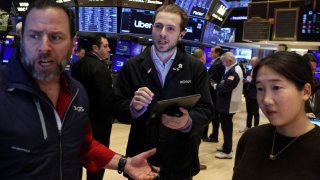
- Bob Parker, senior advisor at trade body International Capital Markets Association, told CNBC he sees signs of a bubble in company valuations and investor concentration in the technology sector.
- However, he does not see a major retreat ahead because of a key difference with previous bubbles.
As tech giant Nvidia soars on hype around artificial intelligence, and global stock indexes notch record highs, debate has grown about whether the stock market has entered a "bubble."
That's generally seen as a period in which asset prices inflate rapidly, potentially beyond their core value — and risk crashing just as fast.
We're making it easier for you to find stories that matter with our new newsletter — The 4Front. Sign up here and get news that is important for you to your inbox.
Bob Parker, senior advisor at trade body International Capital Markets Association, told CNBC's "Squawk Box Europe" on Wednesday he saw signs of a bubble based on two of three main characteristics.
"The first [characteristic] is obviously looking at valuations. If we look at the valuation of Nvidia, justifiably it is actually very high indeed," Parker said, adding that the second sign is investor positioning.
"Whenever you have a market bubble, investors are very clustered or very concentrated, either in one market or in one sector.
Money Report
"And it doesn't matter whether you look at the U.S. or Europe or some of the Asian markets, you know, we've got this historic wide valuation between the tech sector, and obviously AI as a sub-sector of the tech sector, and the rest of the market.. Investors are very clustered in that tech sector," Parker said.
The topic has been dividing market watchers. JPMorgan Chase CEO Jamie Dimon told CNBC on Monday that he does not see AI as a bubble, emphasizing: "When we had the internet bubble the first time around … that was hype. This is not hype. It's real."
Yet Torsten Sløk, chief economist at asset manager Apollo, published a chart this month, comparing the valuations of the top 10 companies in the S&P 500 with their counterparts during the 1990s boom and calling the "current AI bubble... bigger than the 1990s tech bubble."
While he acknowledged the signs of a bubble, Parker is less concerned that it is on the brink of a burst.
His optimism is rooted in the third characteristic of a bubble — investor leverage, or the use of debt for funding.
"If you look at the bubbles in 1999-2000, and then in 2007, one key characteristic was investor leverage. And we had, whether it was retail investors or institutional investors, a very high level of leverage, and that was either through borrowings or it was through derivatives," Parker told CNBC.
A major problem during the 2008 market crash, Parker said, was the opacity of derivative positions and trying to define risk management around complex financial products such as collateralized debt, bond and loan obligations, which caused the subprime mortgage crisis.
"The bottom line was very simple: it was just embedded leverage. So ... I don't think you're going to see a major market reversal like we saw in 2000, or like we saw in 2008, and the main reason for that is that investors don't actually have much leverage.
"Actually, if you look at investor cash positions, positions in money market funds, positions in corporate and investor liquidity, the cash positions sitting on the side are very high."
While he does not see a dramatic market crash, Parker does envision an investor rotation out of areas of concentration into the broader market.
"If you look at the States, will the [small cap] Russell 2000 over the next three to six months outperform the Nasdaq Computer index? Yes, I think it probably will. And that will be a function of this investor broadening out," he said.






